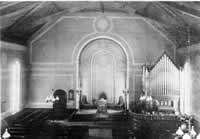
For many, the 1867 Sanctuary at Ewing is a familiar and beloved community landmark, standing tall at “the bend in Scotch Road” in the heart of the Township. For some, it is the place where many of life’s milestones have been marked.
For others, it has been an active, living house of worship surrounded by sacred ground marking those who have gone before. For still others, it is a historic architectural and cultural gem that is the cornerstone of an equally historic three century old cemetery including the graves of 39 Revolutionary War veterans within the crossroads of the American Revolution.
And although the 1867 Sanctuary has now taken on a new life as an arts and cultural center for the region, it still embodies a rich history, which we are pleased to share.
The current stone building is the fourth building built for worship by the First Presbyterian Church of Ewing, the congregation which has continually occupied this site since 1709. The tradition is that a log cabin was built on the site in 1712. It was replaced with a second, wood-frame building in 1726, then with a brick building completed in 1797 and remodeled in 1839. The present stone building was constructed in 1867 to accommodate a growing congregation in the still rural township. Although some minor modifications have been made to the building in the past 150 years, it is largely unchanged.

Built of large, uncoursed local brownstone, this handsome and generally well preserved building is one of New Jersey’s few Romanesque Revival church sanctuaries. Its original steeple, significantly taller than the current one, made the building capable of being seen for miles around in the then-rural landscape. Although the building has a gothic appearance at first glance with its tall and narrow stained-glass windows, tower and pinnacled buttresses, the round-arched window shapes and arcaded corbels represent the earlier medieval style – the Romanesque. Its “Romanesque Revival” style, designed by Philadelphia architect James C. Sidney, was a popular alternative to the Gothic Revival style in the 1850s and 1860s.
The side elevations are 6 bays with flat buttresses between tall round-arched stained-glass windows. The original, pastel-colored glass windows can still be seen on the front facade of the building, on either side of the entrance, and above the door. Twelve stained glass windows in the nave and narthex (lobby) were replaced for the building’s centennial in 1967 with stained and painted glass windows from the Willet Co. in Philadelphia. These windows depict the history of the Christian church from the calling of the disciples to the founding of the Ewing Presbyterian Church congregation in 1709.
The original interior of the Sanctuary boasted stenciled walls, pastel stained glass windows, kerosene lamps, a single, central pulpit on a raised chancel with a central arch behind, solid pews, and soon a pipe organ. The Sanctuary was dedicated on November 20, 1867, with Reverend John Hall of the Trenton Presbyterian Church preaching. The cost of the new, state-of-the-art building? $21,609.70.

Relatively few modifications have been made to the building since 1867. Those that have been made include:
- 1880s: Addition of heat in the building, a gift of Mrs. Harvey Fisk
- 1896: Replacement of original steeple after toppling in “violent wind storm” (tornado?)
- Mid 1940s: Dirt basement floor dug out by youth choir members for choir rooms
- 1951: Organ moved from front to balcony. Chancel divided into two, to accommodate a pulpit and a lectern
- 1983: Sanctuary refurbished, including carpeting and painting
- 1989: Air conditioning added to Sanctuary
- 1990: Exterior ramp added and pews removed to accommodate wheelchair access. First floor restroom added.
- 1994: Solid (red) front doors replaced with glass-paneled doors
Modifications made since Preservation New Jersey took responsibility for the building, and with the approval of the Presbytery of New Brunswick (the “landlord”), include:
- 2014: Installation of life-safety equipment, such as LED emergency lights and exit signs, and fire detection equipment
- 2014: Repair of rotted window sills and wainscotting in the nave
- 2014: Repair of spalling (flaking) brownstone at the entrance
- 2015: Removal of two rows of pews each, in the front and in the back, to accommodate performers and/or flexible seating arrangements in the front, and hospitality and operations activities in the back.
- 2015: Removal of the built-in lectern and pulpit from 1951, to open up the access to and visibility of the chancel/stage area.
- 2015: Some carpeting replaced with wood flooring.

We are honored and pleased to be a part of the history of this magnificent building, and hope that YOU will become a part of that history as well!